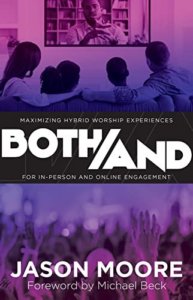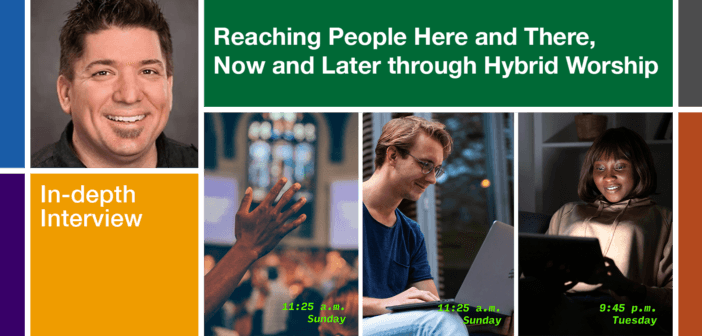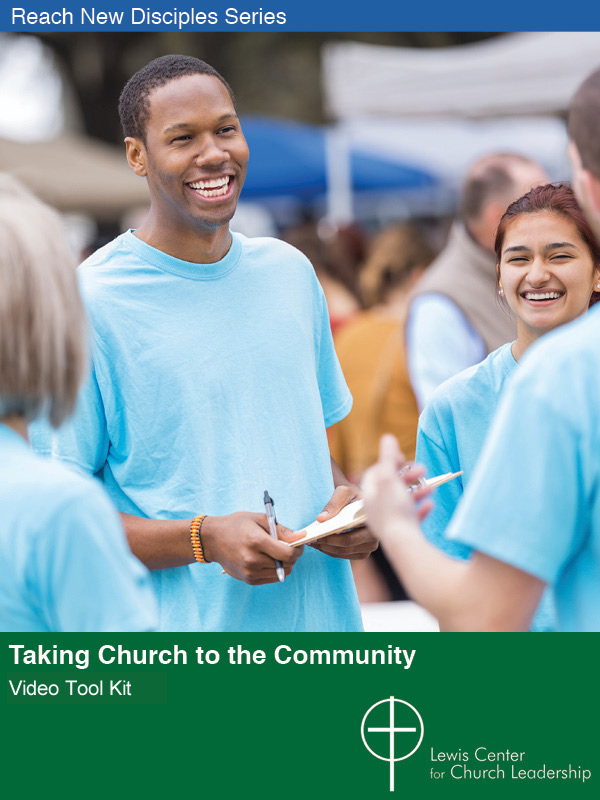How can your worship connect powerfully not only with those in the room on Sunday mornings, but with those worshiping online in the moment and after the fact? Ann Michel of the Lewis Center staff and hybrid ministry expert Jason Moore discuss how simple changes can make your worship more meaningful and participatory for online viewers in the moment and relevant and accessible to anyone at any time.
Listen to this interview, watch the interview video on YouTube, or continue reading.
Ann Michel: Your book describes how in a hybrid world there are several distinct and different audiences, if you will, that constitute a church’s worshipping congregation. Can you name and briefly describe those different segments of people churches can reach through hybrid worship?
Jason Moore: The first segment of the audience are those who are in the room, the people that are right there in front of us in our physical space. Then, you have people who are worshiping with you online in real time. Some are people you know who are connected with your congregation in some way, and others are people that you don’t know who are worshiping online.
Another way to say this is you have people here and there and now and later. We have people that are right here in the room with us now. They’re here. We have people that are there — folks that worship online while we’re doing it in real time. But it’s really important to also consider that we have a lot of people who are worshiping with us later. So, here and there and now and later. And we want to focus on all these groups because the way you communicate with each needs to be a little bit different. For people who don’t know you at all, you need to explain your rites, your rituals, the practices of your worship. If you want to allow them to participate in meaningful ways, you’ve got to equip them to do that.
Ann Michel. You’ve written that in truly hybrid worship each of these different groups feels like they’re the primary audience and none of them are allowed to feel like they’re just an afterthought or an onlooker. And you describe how many standard aspects of our worship may need to be tailored or tweaked a bit to accomplish this. Let’s start with the length of the service.
Jason Moore: It seems people’s attention spans are shorter when they’re at home than when they’re physically present in a worship space. And part of that is because when people are gathered physically we get to control the lighting, the seating, and the symbols in the room. You can’t really control those things when someone is worshiping at home. You can’t prevent the doorbell from ringing or the dog needing to go out or the constant dripping of the coffee maker. Nona Jones (the director of Global Faith-Based Partnerships for Facebook, now Meta, when I wrote Both/And), has studied the data and found that most people will only stay tuned to an online broadcast for about 40 minutes. Yet most of us do worship that is around an hour or even a little bit more.
So, one suggestion I make is to alter the length of your hybrid worship. There are ways to do this in real time. For example, you might invite your online congregation to come in partway into your worship and/or dismiss them early. There are also ways to do it after the fact. You can take that full Sunday morning worship experience that you broadcast or stream, and then create a shorter, curated version. Perhaps edit it down to a 30-minute worship experience which may have a little less in the way of singing. In doing hundreds of seminars on hybrid worship over the last couple years, most people tell me they don’t sing at home. And there are other aspects of worship that don’t transfer so well at home. So I encourage churches to think about how they might create a full worship experience for those in the room on Sunday — the full hour, hour and a half, or whatever it is. And then maybe create an online experience that’s a little shorter. A curated online experience can become kind of a side door entrance into your church if you continually invite to people to come be with you in the building to get the complete experience, as well.
Ann Michel: We’re so locked into the idea that everyone will tune into worship at 11 o’clock on Sunday morning. But that’s not necessarily how people consume online content. Can you help us think about when people worship online?
Jason Moore: In the world of entertainment, you stream movies from home. Rarely ever do you tune in to watch your favorite TV show when it airs live unless it’s a sporting event. A lot of us binge-watch our shows, or we fast-forward them. Why would we think that worship would be any different? I’m not suggesting that worshiping is the same thing as consuming entertainment. But our practices, our habits, the way that we consume information, and the way we participate in experiences have changed quite a bit.
Some people may choose to worship on Sunday evening or Monday afternoon. Maybe they work on Sundays. Maybe they are not early risers. Maybe they’re third-shift workers that can’t get up on a Sunday morning. Maybe they are nursing home residents who gather in a common space and worship at a later time. I work with hundreds of pastors and for maybe three quarters of them their on-delay or on-demand worship numbers are much greater than their Sunday morning live numbers. We don’t want to take attendance anymore just on Sunday. We want to take it all throughout the week. Forever, really. Those numbers accumulate.
Ann Michel: Could you say a bit more about music and singing?
Jason Moore: Music and singing are important aspects of worship. I’m a musician. I love music. I love to sing. But I think there’s something about the experience of communal singing that is different if you’re sitting on your couch, maybe with your family, or in a hotel room, or wherever you may be worshiping online. So, I don’t think we should eliminate music altogether from worship online. But we might abbreviate it a bit or do less singing online than in person. For example, you might have online people join your service after you’ve sung a couple songs, but then say, “If you’d like to experience our entire worship music set today, you can do that on our social media.” Give people the opportunity to opt in rather than asking them to sit through something they’re not likely to participate in.
Ann Michel. What about the style of preaching?
Jason Moore: I think it’s so important to preach in a way that includes online worshipers in the experience. Language really matters. I often hear pastors engaging their audience by saying, “Hey, let me ask for a show of hands ….” or “Just shout out if you ….” People at home can’t shout out loud enough for us to hear them and we can’t see their hands so pastors need to think about how we include everyone in the experience.
It’s also important to give eye contact to everybody, including those who worship at home. If you are preaching to those in the room, you know you need to preach to the people on the left and on the right and in the balcony. But if you only talk to people in the room and don’t ever look at the camera, folks online feel you’re not talking to them. When you look at the camera, they feel like they are part of it. I’m not saying preach only to the camera. You’re not filming a television show. But in the same way you look at the people on the left and the right and in the balcony, you want to do the same for folks online.
I also notice that churches tend to acknowledge their online congregation at the very beginning and the very end of the service and forget about them in the middle. I encourage preachers to find more opportunities to acknowledge people who are here and there. I was at an Easter service and the pastor said, “I’m wearing my favorite suit today. This is a suit I got married in. I look out and see that some of you also have your favorite suits on.” He missed the opportunity to include the online congregation by saying something like, “Did any of you at home get up today and put on your favorite outfit? Or maybe your favorite pajamas?” Just that acknowledgement makes someone worshiping at home, or on vacation, or at the nursing home feel that you are thinking about them, too. “I’m not a viewer of worship. I’m a participant. I’m not a watcher of worship. I am a worshiper online.” Those distinctions are significant and we at we need to really consider them.
Ann Michel: What about the length of the sermon. In your book you lift up the effectiveness of TED Talks, which are 18 minutes long. Is that what should strive for in online sermons?
Jason Moore: Absolutely. Again, our attention spans are shorter when we’re at home. And I think TED Talks are a great example. And there’s some great material out there on how they are done. I know some churches that prerecord their online worship, and the pastor does an 18-minute version for the recording and then the full 25- or 30-minute version live. Also, if you are creating an edited or curated version of your service after the fact, you can shorten the sermon. But you could also take that 18-minute version of your sermon and post it all by itself. People might find a side door into your church because they’ll watch that 18-minute version, but not the full 30-minute version. If we can start delivering an experience of worship that considers the audience tuning in or consuming that content, we have more opportunities to bring more people into relationship with our churches.
Ann Michel: You talk about the potential for online worship to be “evergreen.” Can you explain what that means? And what changes in mindset, language and practice might help our worship live beyond Sunday morning?
Jason Moore: Evergreen worship is worship that can live beyond the moment in which you do it. After living in this hybrid world for a couple years, it’s hard to believe we used to just do church on Sunday and the only people that got to benefit were those in the room. And once it was over, it was just a thought in their heads. One and done. But now our worship can live forever. It’s really exciting that I could preach a sermon on Sunday and, if I have the right keywords and the right title, somebody five years from now could be searching for something and find my sermon that speaks directly to what they’re dealing with.
I encourage churches to think about how they title their sermon videos. A lot of churches will post a sermon with a title like, “First United Methodist Church, Sunday, March 1.” The only people that are going to click on that are people from your church. But if you say, “Finding Your Faith While Experiencing Fear,” someone dealing with fear and looking for faith and searching on YouTube is more likely to find that video and click on it.
I like to remind folks that Paul’s ministry was hybrid. All throughout Acts he’s preaching in person and then he finds himself in prison. And he begins to lead the church from a distance by writing letters. But not only did he lead the church from a distance in his own day, the letters Paul wrote 2,000 years ago still have incredible impact on our lives today. I’d like to think that the worship you do this coming Sunday can have the same impact. Somebody can find it hundreds of years later, through the World Wide Web or whatever comes next, and you can have just as much impact. That’s why I try to help people think about here and there and now and later.
Again, language matters. When we say, “Let’s stand together as we sing. Let’s stand together for the reading of scripture.” Do we really think that people in their living rooms are standing up? If I’m watching the stream on a bus am I going to stand up? Probably not. What if our language was more inclusive of the different ways that people worship now? “If you’re here in the room, I invite you to stand. If you’re worshiping online, find a posture that allows you to fully participate in this moment.” Or maybe we say, “stand in body or in spirit.”
We also need consider how our language can be evergreen. Instead of saying, “Good morning” or “Happy Sunday” or “Boy, it’s really cold out today,” you can open the language up by saying, “Welcome to worship. Hope you’re having a great day!” Also, what instructions do we give to people who are worshiping at a different time? Sometimes, when it comes to prayer, we’ll say, “Come forward if you’d like to pray with someone. The altar rails are open.” Well, that only works for the people in the room. What if we said, “If you’d like to pray with someone, we have care pastors here in the room. If you’re worshiping with us online right now, we have folks in the chat that would love to pray with you. If you’re worshipping with us at a later time, drop your prayer request in the email listed along with this video, and someone will pray for you or even reach out and pray with you.” That allows people to participate in meaningful ways at any time.
Ann Michel: How can congregations help people find and engage this evergreen content online? For churches that are doing a really good job of curated and presenting their content, what does that look like?
Jason Moore: I think that churches don’t consider branding nearly enough. We have incredible content. But we don’t market or brand it very well. We don’t do a great job of telling our story in the most compelling way. So first, I think we need to start branding things a little bit better, wrapping compelling themes and titles around what we’re creating. And then, we need to ask people to share. I’ve consulted a couple of times with Journey United Methodist Church in Columbia, South Carolina. They go by Journey Church. And every weekend in worship, they invite people to open the chat, whether they are in the building or at home. They say, “Right now, go down to that bottom left corner and hit that share button. Let’s invite people to worship with us today.” And on their Facebook page they get between 30 and 50 shares every single week, which means that their online attendance continues to grow all the time.
Ann Michel: How do you see the overall state of digital ministry in 2023? Some people are still so bullish about the growth of online ministry. And others are deeply disappointed by the number of churches who are taking the foot off the pedal in their eagerness to get back to in-person ministry.
Jason Moore: That’s a great question to ask. I think we’re living at a critical juncture in the life of the church. I see it as a Great Commission moment. We can choose to use the experience of the last couple of years as a springboard to reach more people and to take the Gospel to people everywhere. But it’s really disappointing to me that in the last six or eight months I’ve heard more and more people talking about ending their hybrid worship. A pastor recently said to me, “We’re going to stop streaming because we want people to come back to the building.” And I said, “My friend, I appreciate the thinking behind that. But you know, if my favorite restaurant stops offering delivery service, it doesn’t mean that I’m going to get in my car and drive to that restaurant for lunch. I’ll find a different restaurant to order lunch and have it delivered because that’s part of the rhythms of my life these days.” So, I don’t think we can just assume if we stop online worship, people will come back to the building. The harsh reality is some people are never coming back.
Mike Slaughter, former pastor of Ginghamsburg Church and my former pastor, boss, and mentor, would regularly say, “If you put it up for a vote, the people always vote to go back to Egypt.” A lot of us have made our way through the wilderness into the promised land of this new hybrid reality. But some of us felt more comfortable in the past and we’re reverting to the way things were. But the world around us is not reverting. If the church doesn’t embrace this moment, I think you’re going to miss a lot of people.
On monthly cohort calls with the pastors I coach, I will ask, “How many of you have had visitors in your building as a result of your online worship?” And hands go up in every single call. In fact, some pastors say a lot of their regulars now worship at home but also say they have a sea of new faces in front of them who found them online and then migrated to the building. Our online worship is like the taster spoon at the ice cream parlor. People will sample what we’re doing and eventually come in person. So, let’s not end our hybrid worship. Let’s lean into it. And then we’ve got to think about how we move from online worship to online discipleship and other opportunities to connect deeper.
Ann Michel. In the early days of the pandemic, it was remarkable how just about every church, large or small, figured out how to worship in the digital sphere. But as time continues to unfold, I often wonder if we’re going to end up with kind of a bifurcated reality. I wonder whether online worshipers, who aren’t bound by time or place, will gravitate toward the churches, typically larger churches, with high-quality online content? Do you think the future of every church is going to be hybrid?
Jason Moore: I think that’s a fair question to ask. In the same way that not every church has a screen in their sanctuary or not every church is called the do contemporary worship, I would say that hybrid worship may not fit the context of every church. But I think it’s an important aspect of life now. We do life hybrid. My wife is studying to earn a teaching degree through a program where she will never step foot on a campus. And I believe that production values don’t matter near as much as authenticity. In the West Ohio Conference of the United Methodist Church there is a Filipino church that does a living room worship service with just a cell phone. And I believe they’re reaching 1,500 people a week, all over the world. And they do Bible study online. They’re doing extended worship in song. But regardless of the size of our church, we need to start focusing on the discipleship pathways that lead from the online experience into our faith communities. That may take people into the building. But it also may mean deeper online relationships — an online Bible study, a membership class, or whatever. Because faith formation doesn’t happen in an hour on Sunday whether they are in the room or online. We need a way to take people deeper in their faith.
 Jason’s book is Both/And: Maximizing Hybrid Worship Experiences for In-Person and Online Engagement (Invite Press, 2022) by Jason Moore, available at Invite Press and Amazon.
Jason’s book is Both/And: Maximizing Hybrid Worship Experiences for In-Person and Online Engagement (Invite Press, 2022) by Jason Moore, available at Invite Press and Amazon.
Related Resources
- Strengthening Online Worship Beyond the Pandemic by Lovett H. Weems Jr.
- Stop Beginning Worship with Boring Announcements by Jason Moore
- 4 Audiences for Digital Engagement by Jessica L. Anschutz
If you would like to share this article in your newsletter or other publication, please review our reprint guidelines.







